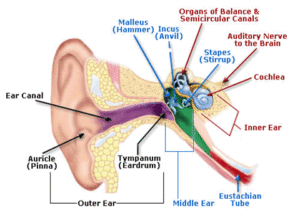How to Pop your Ears Safely and other Ear Popping problems
How to pop your ears safely without causing ear popping problems. We have probably all experienced that uncomfortable sensation of pressure in our ears when we change altitude. Your ears popping by themselves can be uncomfortable. But by popping your ears gradually yourself, you can prevent problems with ear pressure before it results in any pain. In this blog post we’ll tell you how to pop your ears safely.
How to pop your ears safely
Popping your ears safely usually involves changing the pressure difference between your outer ear and the eustachian tubes gradually. It’s best do this well before any pain occurs. Letting the pressure build up until it’s painful can make the problem harder to clear. The pressure can last from a few minutes to a couple of days, until the eustachian tubes can naturally balance the air pressure on both sides of the eardrums. It should not cause any long lasting damage, but how uncomfortable it feels will vary from one person to the next. Young children find the sensation very upsetting at first. If you are suffering from some kind of upper respiratory tract infection your eustachian tubes may be blocked (ear barotrauma). Your doctor may caution against flying in some cases. Otherwise, if you must fly there are plenty of over the counter remedies to help relieve congested ears.Techniques for how to pop your ears
It’s worth trying various techniques to make your ears pop. Here are some common ways to help you:- Chew on sweets or chewing gum, or yawn while changing altitude ascending or descending.
- Use specialized ear plugs called Earplanes which use filters to help regulate air pressure.
- Valsalva manoeuvre: Keeping your mouth closed, pinch your nose shut and attempt to blow out gently.
- Toynbee manoeuvre: Whilst pinching your nose closed, swallow. This will open the eustachian tubes and the movement of the tongue with the nose closed will compress air into the middle ear.
- Frenzel manoeuvre: Use when decreasing altitude. This is a more difficult technique to learn, but safer and used by free divers. If you suffer from ear popping problems frequently then this may be the best technique to learn. A more complete guide is here: Definitive Guide to the Frenzel Technique
- Lowry Technique: This is a combination of the Valsalva and Toynbee manoeuvres. Pinch the nose to close the nostrils, and blow gently and swallow at the same time.
- If you are suffering from ear barotrauma (blocked eustachian tubes) then you should consult a doctor before flying. They can suggest specific decongestants designed to help reduce ear pain.
What Causes Ear Pressure and Pain?
We all know that air pressure decreases as you go higher and increases as you go lower. You can get problems with ear pressure from flying, scuba diving, or even traveling in a lift. Pressure changes in the middle ear cause the uncomfortable sensation. The middle ear is primarily a cavity of air. As we change altitude the air pressure changes outside the ear, but may not change inside the ear, causing an imbalance. This imbalance means that the eardrum is being pushed more on one side by the air pressure. This can result in discomfort and pain if the imbalance becomes too great. The eustachian tube normally equalizes the air pressure between the outside air and the middle ear by opening. Air can then either reach or escape from the middle ear. This causes the popping sensation in our ears. You can prompt your ears to pop by yawning or swallowing as we show below. Adults are usually able to withstand this strange sensation caused by changes in middle ear air pressure. For children it can seem especially odd and even scary at first. Children’s eustachian tubes are more easily affected by inflammation and mucus from ear infections or colds. They can also be blocked by enlarged or swollen adenoids. The pain is temporary and shouldn’t cause any lasting problems as it usually subsides within a few minutes. The eustachian tubes will open to let the air pressure equalize on both sides of the eardrums. Earplanes flight ear protection is an earplug shaped product which uses special filters to regulate air pressure. If your ears don’t clear after a few days or are painful then you should see a doctor to make sure there are no problems. For specific information on flying with hearing aids, our blog post Flying with Hearing Aids covers all you need to know and how easy it is. If you believe your ears are blocked then our post containing tips for unblocking your ears should help.About Hearing Direct
We are one of the world's leading hearing aid specialists. HearingDirect offers a wide range of affordable products, as well as information resources to help improve the quality of life for the hard of hearing. We sell:- Hearing aids,
- Batteries,
- Accessories such as earplugs,
- and amplified devices such as super loud alarm clocks and amplified phones.
Author: Joan McKechnie
 After qualifying as a Speech-Language Pathologist and Audiologist Joan has spent most of her 20 year career in hearing-care related roles. She has a wealth of experience within the hearing aid and hearing rehabilitation fields and has worked in manufacturing environments with two hearing aid companies helping to develop products and roll out new technologies. Joan has been involved with Hearing Direct since its launch and enjoys the online retail environment which seeks to provide easier access to hearing products and accessories. She is HCPC registered. Read Joan's full bio here.
After qualifying as a Speech-Language Pathologist and Audiologist Joan has spent most of her 20 year career in hearing-care related roles. She has a wealth of experience within the hearing aid and hearing rehabilitation fields and has worked in manufacturing environments with two hearing aid companies helping to develop products and roll out new technologies. Joan has been involved with Hearing Direct since its launch and enjoys the online retail environment which seeks to provide easier access to hearing products and accessories. She is HCPC registered. Read Joan's full bio here.

